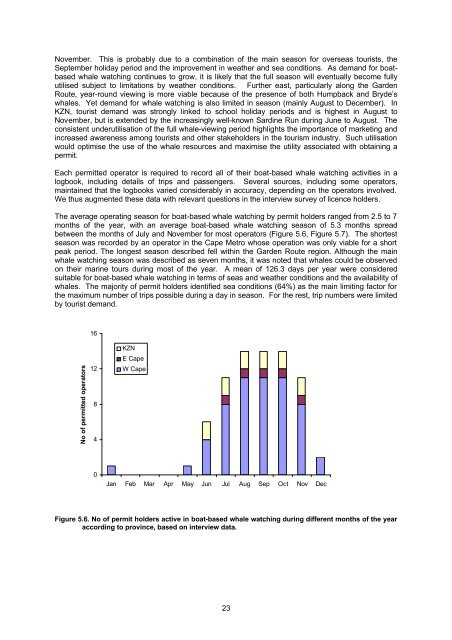Download PDF (2.5MB) - Anchor Environmental
Download PDF (2.5MB) - Anchor Environmental
Download PDF (2.5MB) - Anchor Environmental
You also want an ePaper? Increase the reach of your titles
YUMPU automatically turns print PDFs into web optimized ePapers that Google loves.
November. This is probably due to a combination of the main season for overseas tourists, the<br />
September holiday period and the improvement in weather and sea conditions. As demand for boatbased<br />
whale watching continues to grow, it is likely that the full season will eventually become fully<br />
utilised subject to limitations by weather conditions. Further east, particularly along the Garden<br />
Route, year-round viewing is more viable because of the presence of both Humpback and Bryde’s<br />
whales. Yet demand for whale watching is also limited in season (mainly August to December). In<br />
KZN, tourist demand was strongly linked to school holiday periods and is highest in August to<br />
November, but is extended by the increasingly well-known Sardine Run during June to August. The<br />
consistent underutilisation of the full whale-viewing period highlights the importance of marketing and<br />
increased awareness among tourists and other stakeholders in the tourism industry. Such utilisation<br />
would optimise the use of the whale resources and maximise the utility associated with obtaining a<br />
permit.<br />
Each permitted operator is required to record all of their boat-based whale watching activities in a<br />
logbook, including details of trips and passengers. Several sources, including some operators,<br />
maintained that the logbooks varied considerably in accuracy, depending on the operators involved.<br />
We thus augmented these data with relevant questions in the interview survey of licence holders.<br />
The average operating season for boat-based whale watching by permit holders ranged from 2.5 to 7<br />
months of the year, with an average boat-based whale watching season of 5.3 months spread<br />
between the months of July and November for most operators (Figure 5.6, Figure 5.7). The shortest<br />
season was recorded by an operator in the Cape Metro whose operation was only viable for a short<br />
peak period. The longest season described fell within the Garden Route region. Although the main<br />
whale watching season was described as seven months, it was noted that whales could be observed<br />
on their marine tours during most of the year. A mean of 126.3 days per year were considered<br />
suitable for boat-based whale watching in terms of seas and weather conditions and the availability of<br />
whales. The majority of permit holders identified sea conditions (64%) as the main limiting factor for<br />
the maximum number of trips possible during a day in season. For the rest, trip numbers were limited<br />
by tourist demand.<br />
16<br />
No of permitted operators<br />
12<br />
8<br />
4<br />
KZN<br />
E Cape<br />
W Cape<br />
0<br />
Jan Feb Mar Apr May Jun Jul Aug Sep Oct Nov Dec<br />
Figure 5.6. No of permit holders active in boat-based whale watching during different months of the year<br />
according to province, based on interview data.<br />
23
















